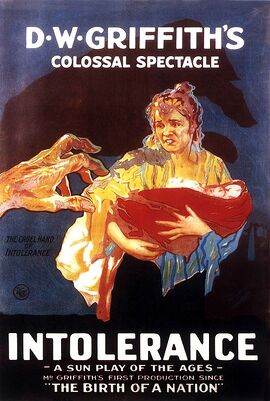Intolerance (1916 film)
 Theatrical poster | ||
| Starring | ||
| Directed by | D. W. Griffith | |
| Produced by | D. W. Griffith | |
| Written by | D. W. Griffith
Hettie Gray Baker Anita Loos Mary H. O'Connor Frank E. Woods | |
| Editing by | D. W. Griffith
James Smith Rose Smith | |
| Music by | Joseph Carl Breil
Julián Carrillo Carl Davis (1989 restoration) | |
| Cinematography | G. W. Bitzer | |
| Distributed by | Triangle Distributing Corporation | |
| Released | Sep 05, 1916 in U.S. | |
| Runtime | 210 minutes (original release)
| |
| Country | United States | |
| language | Silent film with English intertitles) | |
| Budget | $385,907 | |
| Gross | $1.75 million | |
Intolerance is a 1916 American silent-screen anthology directed by D. W. Griffith. Subtitled Love's Struggle Throughout the Ages and A Sun-Play of the Ages, this three-and-a-half-hour epic weaves together four parallel stories, each set in different centuries: a modern-day melodrama about crime and redemption; a Biblical tale: Christ's mission and death; a French story: the events around the St. Bartholomew's Day massacre of 1572; and a Babylonian story: the fall of Babylon to Persia in 539 BC. Each tale had its own distinctive color tint in the original print. The scenes are connected by shots of a figure representing Eternal Motherhood rocking a cradle.
Griffith chose to explore the theme of intolerance partly because his previous film, The Birth of a Nation (1915), was criticized by the NAACP and others for reinforcing racial stereotypes, supporting the Ku Klux Klan, and glorifying their actions. However, intolerance was not intended as an apology; Griffith believed he had nothing to apologize for. In numerous interviews, he clarified that the film was a response to his critics, whom he considered to be the truly intolerant ones. After its release, Intolerance greatly influenced European film movements and is recognized as one of the most significant films of the silent era. In 1958, it was voted number 7 in the World Expo film poll. In 1989, it became one of the first films selected for preservation in the United States National Film Registry.
Storylines
The film consists of four distinct, but parallel, stories—intercut with increasing frequency as the film builds to a climax—that demonstrate mankind's persistent intolerance throughout the ages. The timeline covers approximately 2,500 years.
- The ancient "Babylonian" story (539 BC) depicts the conflict between Prince Belshazzar of Babylon and Cyrus the Great of Persia. The fall of Babylon is a result of intolerance arising from a conflict between devotees of two rival Babylonian gods—Bel-Marduk and Ishtar.
- The Biblical "Judean" story (c. AD 27) recounts how—after the Wedding at Cana and the Woman Taken in Adultery—intolerance led to the Crucifixion of Jesus. This sequence is the shortest of the four.
- The Renaissance "French" story (1572) tells of the religious intolerance that led to the St. Bartholomew's Day Massacre of Protestant Huguenots fomented by the Catholic Royal House of Valois.
- The American "Modern" story (c. 1914) demonstrates how crime, moral puritanism, and conflicts between ruthless capitalists and striking workers help ruin the lives of marginalized Americans. To get more money for his spinster sister's charities, a mill owner orders a 10% pay cut to his workers' wages. An ensuing workers' strike is crushed and The Boy and The Dear One make their way to another city; she lives in poverty and he turns to crime. After they marry, he tries to break free of crime but is framed for theft by his ex-boss. While he is in prison, his wife must endure their child being taken away by the same "moral uplift society" that instigated the strike. Upon his release from prison, he discovers his ex-boss attempting to rape his wife. A struggle begins and in the confusion the girlfriend of the boss shoots and kills the boss. She escapes and The Boy is convicted and sentenced to the gallows. A kindly policeman helps The Dear One find the real killer and together they try to reach the Governor in time so her reformed husband will not be hanged.
Breaks between differing time periods are marked by the symbolic image of a mother rocking a cradle, representing the passing of generations. The film simultaneously cross-cuts back and forth and interweaves the segments across great gaps of space and time, with over 50 transitions between them. One unusual characteristic of the film is that many of the characters do not have names. Griffith wished them to be emblematic of human types. Thus, the central female character in the modern story is called The Dear One, her young husband is called The Boy, and the leader of the local Mafia is called The Musketeer of the Slums. Critics and film theorists maintain that these names reveal Griffith's sentimentalism, which was already hinted at in The Birth of a Nation, as in titles such as The Little Colonel.
Notes
![]() This article has been abridged and edited using Grammarly to make it more user-friendly, and to standardize spelling and text formatting. R/
This article has been abridged and edited using Grammarly to make it more user-friendly, and to standardize spelling and text formatting. R/
External links
- Review Intolerance (1916 film) at the Internet Movie Database
- Intolerance is available for free viewing and download at the Internet Archive|}}
- Intolerance (1916 film) at the American Film Institute Catalog
Chat rooms • What links here • Copyright info • Contact information • Category:Root